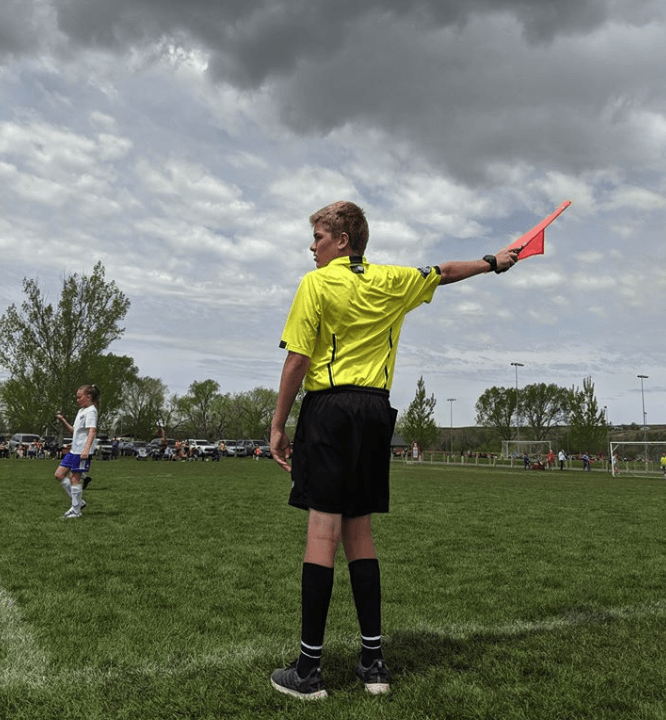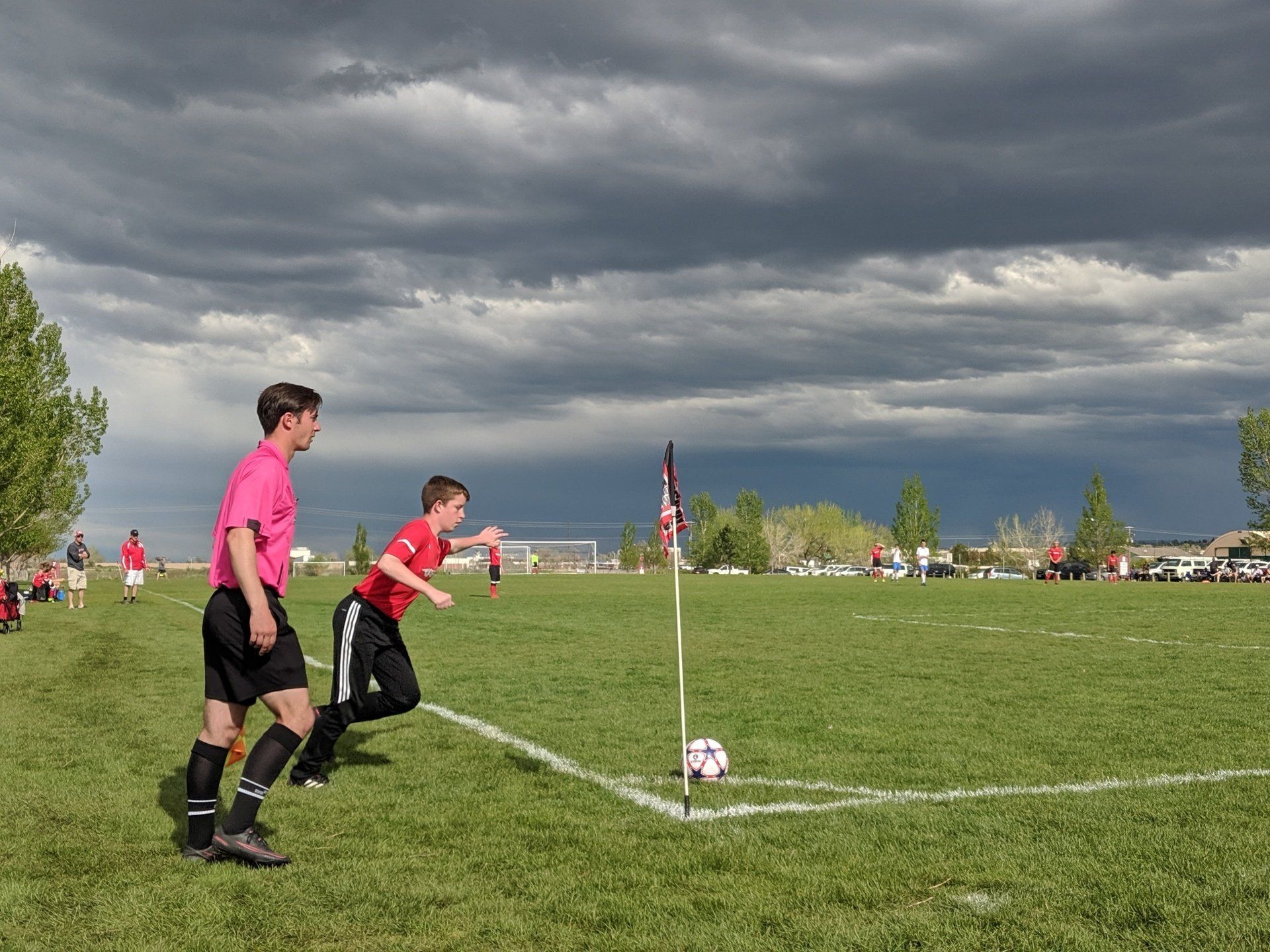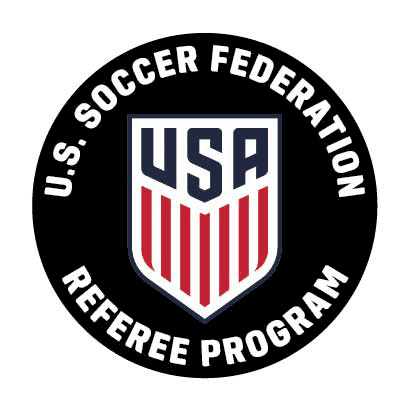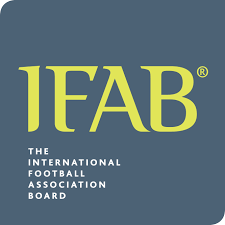3. “Stop slouching!”
Tucked shirt, proper patch placement, the correct socks and being properly equipped with cards, coin, watch, notebook, pen, and whistle aren’t just feel-good details. The reasons behind each become very apparent when you start a match only to realize a few minutes in that you’re not wearing a watch. A young Official learns quickly that there’s a big difference between making the right call and through body language, field positioning, and appearance, “selling” that call to everyone watching. Experienced officials may argue that while both are important the latter is even more so. Yeah, read it again. I just said that…
4. “Are you paying attention?”
With some science contending that Gen Z has the
attention span of a goldfish, few other activities can combat that by demanding distraction-free, wide-eyed, laser-focused attention in the manner only a near non-stop action sport can provide. Your side-stepping offspring could be a flag-in-hand Assistant Referee on the touchline — blink — and find themself just 2 yards off the optimal position for flagging a potentially game-changing offside call. At that point, it’s almost a lock that the loudest voice at the field that day will be standing directly behind your well-intentioned youth to express their dissatisfaction. Ugh. But, he's paying attention now.
5. “Stop mumbling!”
Communication skills, like steel, are best forged in fire. Here’s a common scenario for your ref-gear-clad-budding-adult: Spoken to an 8-year-old in nearly monosyllabic words, “please be sure that both hands come from all the way behind your head on a throw-in. Let’s do that again,” while providing nearly simultaneous instruction to the opposing coach that is losing his mind: “Illegal throw-in! Our ball!” To that coach our young Official is adjusting her tone to a less Sesame Street, sing-songy friendly tone and amping up her confidence while straightening up to meet the red-faced gaze eye-to-eye (tough stuff for a teenage official accustomed to only staring down at a mobile phone): “At U8 Coach, we consider this to be a teachable moment. Your team will not be given the throw-in as they would in an older age group match so that our young players can better learn.” Communication has to be both verbal and non-verbal for the benefit of players, coaches, and fans.
6. “What would you like us to do?”
Pre-flight checklists exist for a reason: To keep passengers safe in the event of an issue. It seems monotonous and almost silly that a crew of professional aviators would go through it for each and every flight. But, experience has taught us that it helps to remove the guess-work when the pressure is on by committing best practices to muscle memory. It puts a crew on the same page. Your young ref will be expected to take part in a pre-game discussion with their officiating crew. Moreover, as the Center Referee, she will be expected to conduct the meeting. She will gauge the level of experience of those working with her and make requests of them that are in-line with their capabilities. She’ll put the match into perspective for the officiating team. They’ll agree on how communications (e.g., substitutions, penalty area calls, unruly coaches and fans) will be handled during the match. “Shouldn’t it be the same for every match,” you ask? “Doesn’t every flight involve a takeoff and landing,” I’d respond? Every match and every crew is different.
7. “I’d better see some hustle!”
An official will walk, jog and sprint roughly 4 to 5 miles to keep up with play during a 14U match. These same officials may work 5 to 7 games on a given tournament day. Tournaments can be 2–3 days. The math hurts the head as much as the running pains the quads, but you get the idea. The challenge isn’t simply keeping up with active play, but remaining mentally sharp all the while so that they can properly apply the Laws to everything happening in front of them, and sometimes behind. Do they simply stand in the middle circle and rotate to watch play like a lighthouse? As a parent, you can simply sit back and let a Coach take the reins on that teachable moment.
8. “So, what’s your answer?”
If you’re a player, fan or coach, you know what direction your team is going. Try making that simple throw-in direction call when you have no team affiliation. Thought bubble: “Did that go off red? Which direction is blue going? Which keeper is on the blue team?” If — nay, “when” — they’re unfortunate enough to make an incorrect nano-second decision on a call that affects the result of a match, it’s likely to tragically loop in their mind like a bad internet gif. Each time, their body replays the sensation they felt during call-magedon. Typically, that’s flushed cheeks, sweaty palms and the burn of a thousand eyes. They’re complained about, yelled at, and dressed in comically colored garb that — despite the vertical stripes — does nothing to help them earn the respect they deserve for managing the fairness of play and safety of players. But, it does lead to #9:
9. “We just need to see progress not perfection”
Few walk away with a tip consisting of a couple of wadded-up singles from having delivered a pizza and performed some introspection along the lines of: “I wonder what I could have done to make that experience better for the customer?” No matter the age of the official or level of the play that they’re assigned to oversee, that reflection is almost automatic post-match. Nobody wants to repeat mistakes made for all to see, and the tools exist to avoid almost all of them. Typically lounging in the Ref tent nursing strained hip flexors and knees are more senior officials, Referee Coaches, Assessors and similar. With degrading body parts, they do form a community of experience waiting to be shared with younger Refs to further empower their future actions. An English Premier League official has on average 275 call/no-call decisions to make per match and misses on 4. That to say: Self-improvement never ends. Perfection is never attained. The sooner your teenager becomes comfortable with processing adverse experiences in a healthy manner the sooner they see adversity as a tool for learning.
So, there you have it. Great parenting, by not parenting, which is almost Zen-like in it’s beauty. Register your teen for a referee course
here.





